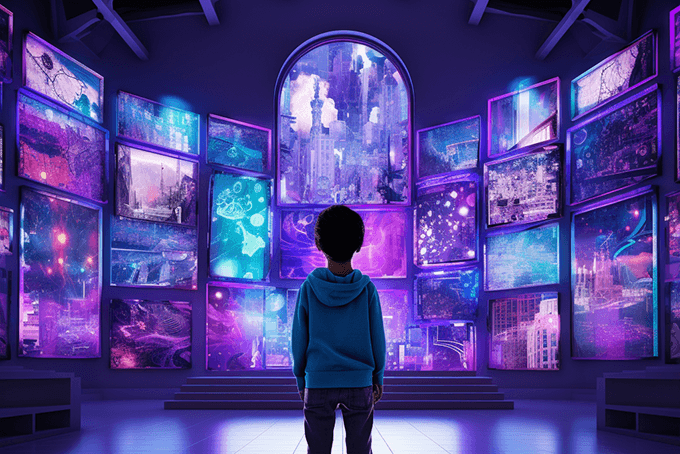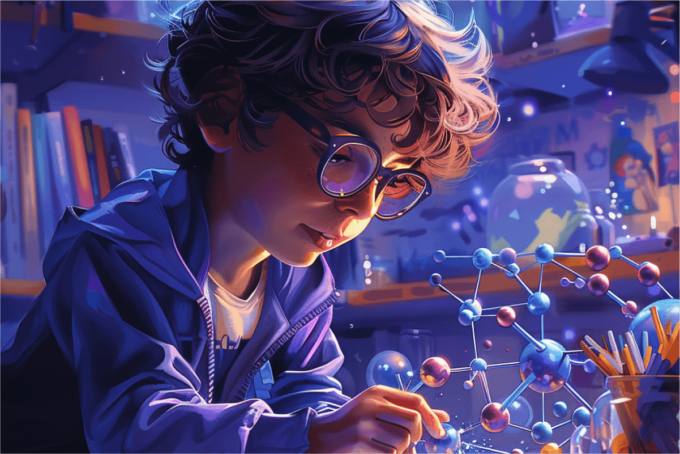Museums are excellent places for children to learn. The informal learning that comes from museums enhances what kids get in school. Museums enable us to supplement the formal, structured, curriculum-driven model encountered in classrooms. Minda Borun, Director of Research and Evaluation at The Franklin Institute Science Museum in Philadelphia defines informal learning as learning that “takes place … at home, at community gatherings, in parks and playgrounds, and in museums. It is how we learn to use utensils, put on our clothes, brush our teeth and carry out the activities of daily living. Informal learning often occurs through observation, imitation, and apprenticeship rather than through deliberate instruction.”
Lev Vygotsky’s Theory of Cognitive Development
The notion of “informal learning” has led to shifts in exhibit design, especially regarding the way information is presented to children. Museums allow kids to get away from the top-down approach they get from schools and benefit from the social factors involved in cognitive development as developed by Lev Semyonovich Vygotsky, a renowned Soviet psychologist. Lev Vygotsky pioneered the concept of the “zone of proximal development. By this he meant the level of development that’s immediately above the learner’s current level. It is there that children receive input from the culture at large and teachers, parents and peers, all of whom would use what Lev Vygotsky called “scaffolding” tools to enable the child to reach the next level of cognitive development.
What is Effective Learning
Much as a classic classroom experience involves the one-to-one instruction from teacher to student, older-style museum exhibits attempt to educate the visitor via the curator, the subject matter expert. The knowledge transfer in both of these contexts is typically one-to-one, i.e., the teacher/curator informs the individual student/visitor. Traditional labels on museum walls are similar to how knowledge is conveyed in schools and may be detrimental to effective learning. As Saul Carliner, an internationally known expert on e-learning and information design has noted, “[t]his reference-like approach to displaying objects created a barrier between museums and the public. The public was overwhelmed with the quantity of objects and the technical language and detail of the documentation. In fact, studies indicated that few visitors actually read labels and, of those who do, most spend less than half a minute doing so.”
Museums That Provide Informal Learning Opportunities
What, then, would a Vygotskyan approach to museum exhibits look like and how would it accommodate concepts such as shared problem-solving and the roles of parents and peers? Two case studies can help illuminate this question.
Based on sensory exploration, the New York Hall of Science’s Preschool Playground is an exhibit in a museum best described as a hands-on science center with “over 450 permanent exhibits.” In response to an increase in visitors under age 6 between the mid-1990s and the end of that decade (25% vs. 50%) the Hall decided to design an exhibit that would engage young children and their caregivers. The goal was for the exhibit to foster interactivity, between the children and the exhibit, amongst the children themselves and between the children and adults.
As the exhibit designers stated, the goal was to “provide basic tools to shape exploration and an open environment that encourages a child’s natural curiosity.”The Preschool Playground consists of a number of different paths that function as a sort of outdoor classroom. This exhibit supports learning and discovery by encouraging children to learn interactively from the natural world.
The paths are organized around different themes. The Bridge Path connects two hills and encourages movement; the Sheltering Path features a series of structures that allow children to imagine and interact with the role shelters play in nature; the Sand Path invites children to use natural materials to experience construction; the Music and Water Path fosters performance and interaction with water and its properties; and the Mirror Path with its reflective surfaces persuades children to experience reflections of the natural world.
Similarly, the Children’s Discovery Museum of San José’s Wonder Cabinet seeks to be a place where “young children expand their imaginations as they use all of their senses to explore the environment” through hands-on exploration. The Cabinet includes areas such as the “Woodland Puppet Forest” (a place to explore stories, with woodland animals as puppets); the “Sand Science Laboratory” (an area for exploring sand replete with authentic science equipment such as scales and beakers); the “Crawl-Through Tunnel”; the “Pretend Area” (for dramatic play); and the “Giant Kaleidoscope” (where kids are inside a kaleidoscope with its three mirrors). All these features exemplify the “Museum’s exhibit philosophy [which] is rooted in its mission, and responds to the distinctive need for children to learn through concrete interactions — touching, exploring, manipulating and experimenting.”
Ideal Learning Environments
As museum consultant Paulette M. McManus points out, “[i]n formal educational situations, where you will learn, who you will learn with, whether you are qualified to learn, who you will learn from, what you will learn, how long you will be given to learn it, and agreement on what you have learned and your level of understanding are matters largely out of control of the individual learner… In contrast, informal education in museums is entirely free of choice in every respect.” In that sense museum exhibits and the interactive dynamics they engender are the ideal testing ground for examining the problem solving and knowledge construction displayed by children. Ideally museums can serve as an alternative learning model to the traditional classroom in one important dimension. Rather than espousing the acquisition of new facts and information from an expert, museums can aid in the social construction of knowledge through the efforts of all visitors—children and their caretakers alike.
Effective Teaching Strategies
Educators would do well to incorporate the lessons of informal learning and shared problem solving into their practices. Eschewing the example of museum labels as conveyors of knowledge, educators should focus on the social and interactive development of knowledge. Specifically, this goal could be achieved by:
- Replacing instructional questions with more open-ended inquiries
- Promoting hands-on activities
- Fostering social learning with individuals that have varying levels of expertise
Sample Lesson Plan
Imagine a “tic-tac-toe” informal activity to supplement informally the information students will have learned about the solar system. This activity could be played physically or on the web. Imagine a grid of nine squares:
X X X
X X X
X X X
Behind each square is a question about the solar system that prompts answers that pertain to the instructional material covered. For instance, “Which planet is the same size as earth’s moon?” [Mercury]; “Which planet has the ‘Great Red Spot’?” [Jupiter]; “Which planet is often called the morning or evening star” [Venus]; etc. If the student provides the right answer, s/he claims the square, with the usual rules for winning tic-tac-toe. Providing the wrong answer results in losing the square and possibly the entire game eventually.



